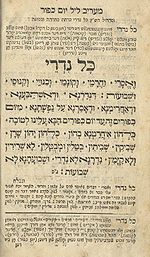Yom Kippur has just ended, which means that my belly is totally crammed full of food. But beyond fasting, there's more to this holiday.
Yom Kippur is the holiest day of the Jewish year. It can be summed up as follows:
- What Jews do on Yom Kippur: pray
- What Jews don't do on Yom Kippur: everything else
The highlight of Yom Kippur, for me, is Kol Nidrei. This prayer (actually, it's a recitation and not a prayer) was popularized by Max Bruch's orchestral version for cello and orchestra. Personally, I prefer solo cello; solo viola is also quite good. But many congregations don't use instruments. It's up to the Chazan (cantor) to make Kol Nidrei inspiring. The traditional Ashkenazi (eastern European) tune is like this; it is similar to the orchestral tune. Since we're attending a Sephardi (Spanish) synagogue, I was hoping for something like this (a Moroccan tune) or like this (a Middle Eastern tune). Alas, it wasn't to be, but it was special.
There are all sorts of differences between Yom Kippur here and Yom Kippur at home. For me, the biggest are:
- Yom Kippur here is for casual dress. My long sleeve button down and khakis are almost overdressed. Many people wear white exclusively.
- One of the prohibitions is against wearing leather. It was considered a luxury and that's a no-no. So people wore canvas shoes. Crocs are popular in some circles. Other people are barefoot.
- Yom Kippur is a social occasion. While the Rabbi and Chazan are leading the service, there are at least half a dozen conversations happening.
- Yom Kippur is a time to be seen and then leave -- some families showed up today for 30 minutes (or less) and then left.
The traditional greeting for Yom Kippur is גמר חתימה טיבה (g'mar chatimah tovah; May you be sealed in the Book of Life). For all of you who celebrate, may this be the case.




No comments:
Post a Comment